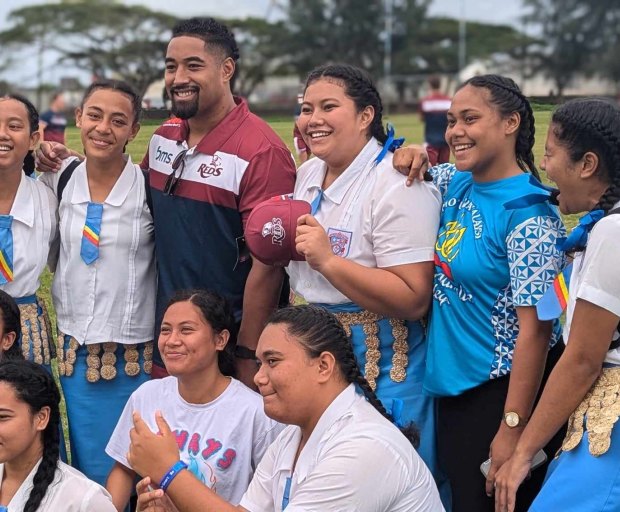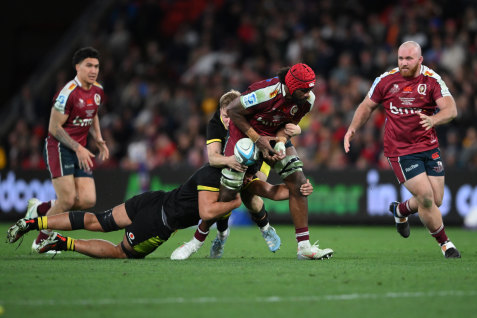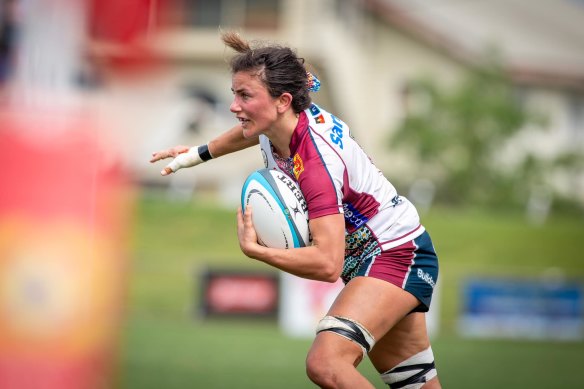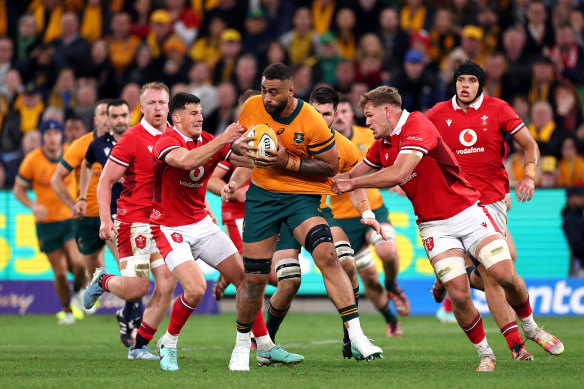This was published 10 months ago
I joined the Reds in Tonga, and left confident a title force had arrived
By Nick Wright

Feleti Kaitu’u has a fan favourite among school students in Tonga.Credit: Nick Wright
There was more to the Queensland Reds’ mission in Tonga than achieving victory in two historic clashes.
Helping usher in a greater rugby presence in the Pacific, establishing the club as a Super Rugby powerhouse, and launching the most crucial five years of the women’s game were among the lofty ambitions.
And given what athletes from the Pacific have contributed to the game, engaging there in a greater capacity will be paramount to success.
Engaging the Pacific
Former Wallaby Feleti Kaitu’u received a raucous cheer on a Tonga school trip as he addressed students in the native language.
Widespread touch footy games ensued, prop Jeffery Toomaga-Allen a fan favourite.
But this was about more than ticking some boxes. There was an opportunity to grasp a passionate sporting region – one represented by 52 players between Tonga, Samoa and Fiji across 2023’s five Super Rugby sides.
“I think bringing in the Pacific Nations is important for our sport. You look at every team we play, and they have some Pacific Islander – Tongan, Samoan, Tahitian – there’s always some Pacific blood,” Toomaga-Allen said.
“It’s always nice to come back and play those nations and give back to the communities that contribute so much to our sport.
“The passion in our people is very strong, so you can’t fault us whether they’re winning or losing – they will always back you.”
For governments, geopolitical influence in the Pacific has become a key battleground, and with support from PacificAus Sports, the Reds sought to strengthen the nations’ bond.
Coaching clinics, spearheaded by Wallabies and Wallaroos greats George Smith and Bree-Anna Brown, aimed to upskill Tonga’s developing mentors and produce finer players as a result.
At an end-of-tour cocktail party, five-eighth James O’Connor could be seen discussing plays with his Tongan counterpart.
The bonds forged off the field have strengthened ties between the two nations, and the hope is that a solidified union has been created.
“The Pacific’s us, isn’t it? It’s part of us. We have a lot of Pacific Island men and women living in Australia, and Queensland, so to be able to connect to those communities is massive,” Reds coach Les Kiss said.

Seru Uru of the Reds is tackled during Queensland’s recent clash against Wales.Credit: Getty Images
“The opportunity to come out here and do some stuff in schools and the skills that we did with them, and the coaching courses, all those things are fantastic.
“If they’re willing to help promote that, we’re very willing to support it.”
Most crucial five years for women’s code launches
If Australia is going to allow the women’s game to thrive, the next five years will be the most crucial in the code’s history.
And Queensland’s 65-0 drubbing of Tonga highlighted the need for more regular fixtures leading up to the 2029 home World Cup.
Reds outside centre Melanie Wilks was emphatic in the victory, scoring two brilliant solo tries, while linking with fullback Lori Cramer to unleash the rest of the backline.
Carola Kreis also helped herself to a hat-trick.

Carola Kreis in action against Tonga.Credit: Reds Media
But the chance to perform against international rivals will not only benefit the nation’s talent, but their counterparts worldwide.
Just look to England’s success – who have finished no lower than third in all nine World Cups on the back of an 18-game domestic season and annual Six Nations.
In February, the federal government announced a $14.2 million partnership with Rugby Australia to invest in high-performance rugby union in the island regions across the next four years.
The Matildas showcased what a palpable statement in a world showcase on their own turf could achieve during last year’s Women’s FIFA World Cup, injecting $1.32 billion into Australia’s economy.
If the Wallaroos are to replicate that success, they need to be exposed to more elite rugby.
Injection of depth
James O’Connor’s history in world rugby was always going to make him a popular attraction.
Just ask one fan who wore a wedding dress, brandishing a “Marry Me” sign.
But given Queensland had more than a dozen players unavailable for the 41-14 Tonga triumph, this loomed as the chance for several fringe men to stand up.
Backrow duo Joe Brial and John Bryant did just that.
The pair will find themselves on the interchange when Wallabies trio Liam Wright, Fraser McReight and Harry Wilson return for the 2025 season.
But in torrential conditions in Nuku’alofa, the “JBs” set the tone.
The lessons they took from the heartbreaking final-minute defeat to Wales had stuck – just as Kiss had intended – as they put on a defensive masterclass against a giant Tongan pack, and attacked with vigour around the ruck.
The Tonga trip also brought the talents of rookie prop Massimo De Lutiis to the fore – the hulking 20-year-old, who already stands as the strongest Queensland player of any football code.
Kiss’ depth has already received an injection following the demise of the Melbourne Rebels – with Wallabies Lukhan Salakaia-Loto and Filipo Daugunu joining the fold next season.
“The big thing is why would we batter each other at training and not do it in the game? If we can do it to our own jerseys, then it has to be tenfold against another jersey,” Toomaga-Allen said.
“To see we could go toe to toe with an international squad just goes to show how far we’ve developed in our strength in the team and the depth that we have.
“It was just good resilience – over previous years I think the Reds kind of lost that, if I’m honest. Then it was evident during the Super season that we weren’t going to give up in a fight.”
Can the Reds’ globetrotting escapades make them a force?
Salakaia-Loto admits he always had in the back of his mind he would don the Reds’ jersey again.
Leaving the club at the end of 2022 to head overseas, the 27-year-old’s two-year stint with Northampton Saints took his game to new heights.
But he is no guarantee to be in a starting jersey.

Lukhan Salakaia-Loto will return to the Queensland Reds for the 2025 season.Credit: Getty Images
Second-row duo Angus Blyth and Ryan Smith earned their first Test camp call-ups after breakout campaigns, with the forthcoming international tours only expected to elevate their abilities further.
It is a task Salakaia-Loto is relishing. He has already experienced what global exposure can do for a player.
“You’re only as good as your competition,” Salakaia-Loto said.
“I think the experiences that I gained overseas will be really valuable, and hopefully, I can use that to help some of the young guys there at Ballymore.
“Getting a bit of an insight into what they’re bringing to Ballymore and the changes that they’ve made is exciting.
“You only have to speak to the boys who are in the locker room, hopefully it’s a recipe for success.”
The Reds climbed to fifth by the end of the 2023 campaign, but three wins over New Zealand rivals – and tight defeats to the Hurricanes and Blues – showed there is life in this squad.
These two “Test matches” against Tonga and Wales showcased a determined spirit in this team, with visits to Japan and England to follow before next season.
Such exposure to fresh environments, different brands of rugby and unique challenges works on two fronts for Kiss: a compelling recruitment and retention tool, and vital experiences for his developing squad.